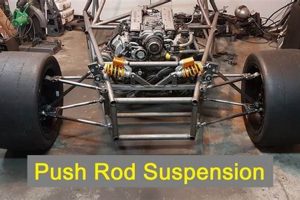A do-it-yourself cooling system represents an alternative approach to regulating indoor temperatures using readily available materials and basic construction techniques. These systems, often created to provide localized cooling, range from simple evaporative coolers constructed from fans and damp cloths to more elaborate designs incorporating ice or water reservoirs. For example, a common setup involves directing a fan’s airflow across a container of ice water to produce a cooler breeze.
The appeal of these constructions lies in their potential affordability and accessibility, particularly in situations where conventional air conditioning is either unavailable or financially prohibitive. Historically, resourceful individuals have devised similar methods to combat heat in environments lacking sophisticated climate control. This resourcefulness fosters innovation and provides a tangible solution to immediate environmental discomfort.
The subsequent sections will explore the practical aspects of constructing such systems, including design considerations, material selection, safety precautions, and a comparative analysis of their performance against conventional cooling technologies. The intent is to provide a comprehensive overview of this accessible cooling method.
Tips for Constructing a DIY Air Conditioner
Effective construction necessitates careful planning and attention to detail. The following tips provide guidance on building a functional and safe cooling system.
Tip 1: Prioritize Safety. Before commencing any construction, ensure electrical components are properly insulated and protected from water. Avoid creating potential shock hazards. Always disconnect power sources before making adjustments.
Tip 2: Select Appropriate Materials. Choose durable and non-toxic materials for construction. Avoid using metals that can corrode in contact with water, and ensure any plastics are food-grade if used to contain water intended for evaporative cooling.
Tip 3: Optimize Airflow. Design the system to maximize airflow across the cooling medium. A strategically positioned fan, directing air through or over ice or water, will enhance cooling efficiency. Consider using ductwork to direct the cool air where needed.
Tip 4: Manage Condensation. Condensation is a natural byproduct of cooling. Implement a system to collect and manage this condensation to prevent water damage or mold growth. A simple tray or drainage system can be effective.
Tip 5: Experiment with Cooling Media. While ice is a common choice, consider alternatives such as frozen gel packs or evaporative cooling pads. Experiment to determine the most effective and sustainable cooling medium for the specific environment.
Tip 6: Regularly Maintain the System. Clean the system regularly to prevent the buildup of mold, algae, or other contaminants. Disinfect water reservoirs and replace cooling pads as needed to maintain optimal performance and hygiene.
Tip 7: Consider Energy Efficiency. While providing an alternative to conventional air conditioning, it’s important to minimize energy consumption. Use low-wattage fans and optimize the system’s design to maximize cooling output per unit of energy consumed.
Following these guidelines will aid in the construction of a functional and relatively safe system. However, understand that these creations are not substitutes for professionally engineered cooling systems and may not provide the same level of performance or efficiency.
The concluding section will offer a comprehensive summary of the critical considerations in using this alternative approach to cooling.
1. Cooling Mechanism
The efficacy of a do-it-yourself cooling system is fundamentally determined by its underlying cooling mechanism. In most systems, this mechanism is evaporative cooling, a process wherein the evaporation of water absorbs heat from the surrounding air, thereby reducing its temperature. The direct correlation between the rate of evaporation and the degree of cooling is significant. For instance, a system employing a larger surface area for water evaporation, achieved through a wetted pad or atomized spray, will typically exhibit a greater cooling capacity than a system with a limited water surface. The ambient humidity directly affects this mechanism; drier air facilitates faster evaporation and a more pronounced cooling effect.
Alternative cooling mechanisms, while less common in do-it-yourself applications, include the use of ice or frozen materials to directly cool the air. In such cases, the transfer of heat from the air to the ice results in a temperature decrease. The rate of heat transfer is dependent on factors such as the surface area of the ice, the airflow rate, and the temperature difference between the air and the ice. A practical example involves directing a fan’s airflow across a container of ice, resulting in cooler air being circulated. The effectiveness of this method is limited by the amount of ice and the rate at which it melts, necessitating periodic replenishment.
In conclusion, the cooling mechanism is the central operational principle of any do-it-yourself cooling system. Whether through evaporative cooling or direct heat transfer, understanding and optimizing this mechanism is crucial for achieving desired cooling effects. Challenges lie in effectively managing water evaporation, maintaining consistent ice supplies, and adapting the design to varying environmental conditions. The success of any such endeavor hinges on a clear grasp of these fundamental thermodynamic principles.
2. Component Selection
Component selection is a critical determinant of the performance, efficiency, and longevity of a do-it-yourself air conditioner. The choice of each component directly influences the system’s ability to effectively cool air, its energy consumption, its durability under operating conditions, and its overall safety. For example, selecting an undersized fan will limit airflow, reducing cooling capacity, while using incompatible materials for water reservoirs can lead to corrosion and system failure. A system relying on a pump to circulate water necessitates selecting a pump with appropriate flow rate and head pressure to ensure adequate water distribution across the cooling medium. The effectiveness of evaporative cooling hinges on component compatibility and the characteristics of these individual parts.
Practical applications highlight the importance of informed component choices. Consider a system utilizing evaporative cooling pads. The selection of pad material dictates water retention, airflow resistance, and resistance to microbial growth. Cellulose pads, while inexpensive, degrade more quickly than synthetic alternatives and may promote mold growth if not properly maintained. Similarly, the type of container used to hold water influences evaporation rates. A shallow, wide conta
iner exposes a larger surface area, enhancing evaporation compared to a deep, narrow container. In terms of electrical components, using appropriately rated wiring and fuses is vital to prevent overheating and potential fire hazards. These practical examples demonstrate that component selection is not merely a matter of convenience but a crucial factor influencing the overall success and safety of the cooling system.
In summary, component selection is paramount in the design and construction of a functional and reliable DIY air conditioner. The interconnectedness of the components dictates the system’s performance, efficiency, and safety. Challenges arise from balancing cost considerations with the need for durable and effective components. Furthermore, an understanding of material properties and their interaction within the system is crucial for successful implementation. Therefore, careful consideration of component selection is essential to building a cooling system that meets performance expectations and operates safely over an extended period.
3. Airflow Optimization
Airflow optimization is paramount to the performance of a do-it-yourself air conditioner. The efficiency with which a DIY system cools air is directly proportional to the volume and velocity of air passing through or across the cooling medium. Effective airflow ensures maximum heat transfer and efficient evaporation, if the system utilizes that method. Understanding and implementing strategies to optimize airflow is crucial to realizing the potential of a DIY cooling solution.
- Fan Selection and Placement
The type and placement of the fan are fundamental to airflow. Axial fans are commonly employed for their ability to move large volumes of air, while centrifugal fans provide higher static pressure, suitable for ductwork. Fan placement should ensure even distribution of air across the cooling medium, avoiding dead spots. Improper fan selection or placement will result in uneven cooling and reduced overall performance. For instance, a small desk fan used with a large evaporative cooler will create localized cooling but fail to adequately cool the entire target area. Alternatively, an inappropriately powerful fan will quickly deplete ice or water reserves.
- Ductwork and Airflow Direction
The implementation of ductwork allows for directing cooled air to specific locations. This is particularly useful in larger spaces or when targeted cooling is desired. Ductwork design should minimize bends and obstructions to reduce airflow resistance. The direction of airflow is also crucial; directing cooled air downward, taking advantage of natural convection, enhances comfort. An example would involve using flexible ducting to direct cool air from a window-mounted evaporative cooler to a specific area of the room.
- Cooling Medium Density and Arrangement
The density and arrangement of the cooling medium impact airflow resistance. Densely packed materials impede airflow, reducing cooling efficiency. Conversely, loosely packed materials may not provide sufficient surface area for effective heat exchange. The arrangement should ensure even distribution of air through the medium, maximizing contact time. If using ice, arranging it in a manner that allows air to flow freely around each piece optimizes cooling. With evaporative media, the material needs a balance between air flow and evaporative surface.
- Sealing and Insulation
Unintentional air leaks undermine the performance of any cooling system. Sealing gaps and cracks in the system enclosure prevents the loss of cooled air. Insulation minimizes heat transfer from the surrounding environment, maintaining lower temperatures within the system. This is particularly important for systems utilizing ice, where insulation reduces melting rates. A well-sealed and insulated system will exhibit significantly improved cooling efficiency compared to one with air leaks and poor insulation.
These factors underscore the importance of airflow optimization in a do-it-yourself cooling system. By carefully considering fan selection, ductwork, cooling medium arrangement, and sealing, it is possible to maximize cooling effectiveness. The interplay between these facets dictates overall system efficiency, and a holistic approach is essential for realizing the full potential of a DIY air conditioner.
4. Power Source
The selection and management of the power source are fundamental considerations in the design and operation of any do-it-yourself air conditioner. The reliability, efficiency, and safety of the cooling system are inextricably linked to the characteristics of its power supply. A thorough understanding of power source options and their implications is essential for constructing a functional and sustainable DIY cooling solution.
- AC Mains Power
Utilizing standard AC mains power is the most common approach for powering DIY air conditioners. This method provides a stable and readily available power source. However, it necessitates adherence to electrical safety regulations and the proper use of grounded outlets and surge protection. Selecting appropriately rated wiring and fuses is crucial to prevent overloads and potential fire hazards. For example, connecting a high-wattage fan to an inadequate power circuit can lead to overheating and electrical failure.
- Battery Power
Employing batteries offers a portable and potentially off-grid power solution for DIY cooling systems. Battery-powered systems are particularly useful in environments where AC mains power is unavailable. However, battery capacity and discharge rates must be carefully considered to ensure sufficient run time. Furthermore, the type of battery (e.g., lead-acid, lithium-ion) influences system weight, cost, and charging requirements. A small evaporative cooler powered by a USB fan connected to a portable power bank is a practical example of a battery-powered solution. This system’s cooling duration is limited by the power bank’s capacity and the fan’s energy consumption.
- Solar Power
Harnessing solar power provides a renewable and sustainable energy source for DIY air conditioners. This approach requires the integration of solar panels and a charge controller to regulate battery charging. The size and efficiency of the solar panels determine the system’s power generation capacity. A DIY cooling system utilizing a small solar panel to power a low-wattage fan during daylight hours exemplifies this approach. The feasibility of solar power is dependent on sunlight availability and the energy demands of the cooling system. Excess power can be stored in batteries for nighttime operation.
- USB Power
USB power offers a convenient and low-voltage option for powering small DIY cooling devices, such as personal evaporative coolers using small fans. These USB fans and other components have low power requirements. The current limitations of USB often prevent its use in a larger system.
In summary, the selection of an appropriate power source is a critical aspect of DIY air conditioner design. AC mains power offers reliability, while battery power provides portability, and solar power promotes sustainability. Each power source exhibits distinct advantages and limitations, which must be carefully evaluated to ensure a functional, efficient,
and safe cooling system. The choice depends on the intended application, available resources, and environmental considerations, and a thorough understanding of these parameters is crucial for successful implementation.
5. Environmental Impact
The environmental impact of a do-it-yourself air conditioner represents a multifaceted consideration, encompassing resource consumption, energy efficiency, waste generation, and potential ecological consequences. Evaluating these factors is crucial for determining the overall sustainability and ethical implications of constructing and utilizing such a system as an alternative to conventional cooling technologies.
- Energy Consumption and Carbon Footprint
The energy required to power a DIY air conditioner contributes directly to its carbon footprint. Systems relying on electricity generated from fossil fuels increase greenhouse gas emissions. Even battery-powered systems carry an environmental cost due to the energy-intensive manufacturing processes involved in battery production and the eventual disposal of depleted batteries. Solar-powered systems, while representing a more sustainable option, still necessitate the initial environmental impact associated with the manufacturing of solar panels. The selection of energy-efficient components, such as low-wattage fans and pumps, mitigates this impact to some degree, but a thorough assessment of the energy source and its associated environmental burdens is essential.
- Water Usage and Resource Depletion
Evaporative cooling, a common mechanism in DIY air conditioners, consumes water. In regions facing water scarcity, this consumption can exacerbate existing environmental challenges. The source of the water, whether from municipal supplies or natural sources, also influences the environmental impact. Utilizing rainwater harvesting or recycled water reduces the demand on potable water resources. Furthermore, the disposal of water used in cooling systems, particularly if treated with chemicals, requires responsible management to prevent contamination of water sources. Considerations of water usage are vital to avoid unintended environmental consequences.
- Material Selection and Waste Generation
The materials used to construct a DIY air conditioner contribute to its overall environmental impact. Selecting recycled, repurposed, or biodegradable materials minimizes resource depletion and reduces waste generation. Conversely, the use of non-recyclable plastics, metals that corrode easily, or toxic components increases the environmental burden. The end-of-life disposal of the system also presents a challenge. Components that cannot be reused or recycled contribute to landfill waste, potentially releasing harmful substances into the environment. Implementing a design that facilitates disassembly and material recovery extends the life cycle of the system and minimizes its environmental footprint.
- Refrigerant Use (if applicable)
While less common in basic DIY systems, some more advanced designs might incorporate refrigerants to enhance cooling capacity. The use of refrigerants, particularly older hydrochlorofluorocarbons (HCFCs), poses a significant environmental risk due to their ozone-depleting potential and contribution to global warming. Even newer hydrofluorocarbons (HFCs), while less damaging to the ozone layer, are potent greenhouse gases. If refrigerants are used, selecting environmentally friendly alternatives with low global warming potential is crucial. Proper handling and disposal of refrigerants are essential to prevent their release into the atmosphere.
In conclusion, the environmental impact of a DIY air conditioner is a complex issue influenced by various factors, including energy consumption, water usage, material selection, and potential refrigerant use. A comprehensive assessment of these factors is essential for making informed decisions and minimizing the environmental footprint of these alternative cooling systems. The long-term sustainability of DIY air conditioning depends on embracing responsible practices and prioritizing environmental stewardship.
6. Safety Protocols
The implementation of robust safety protocols is paramount in the design, construction, and operation of any do-it-yourself air conditioner. The inherent risks associated with combining electrical components, water, and homemade construction necessitate a comprehensive safety-first approach. Failure to adhere to established safety guidelines can result in electrical shock, fire hazards, and other potentially life-threatening situations. Therefore, a clear understanding and strict adherence to established safety protocols is essential.
- Electrical Safety and Grounding
Electrical safety constitutes a primary concern due to the integration of electrical components, such as fans and pumps, within a potentially wet environment. Proper grounding is critical to prevent electrical shock in the event of a fault. All electrical connections must be insulated to prevent accidental contact with water or other conductive materials. For example, utilizing a ground fault circuit interrupter (GFCI) outlet provides an additional layer of protection by immediately cutting off power in the event of a ground fault. Ignoring these precautions can lead to severe electrical injury or death.
- Water Leakage and Short Circuits
The presence of water within a cooling system introduces the risk of water leakage and subsequent short circuits. Precautions must be taken to prevent water from coming into contact with electrical components. This includes utilizing waterproof enclosures for electrical connections and implementing a robust drainage system to manage condensation and accidental spills. For instance, ensuring that all wiring is elevated above the water line and employing sealed connectors can significantly reduce the risk of short circuits. Water damage can lead to equipment failure and potential fire hazards.
- Structural Integrity and Stability
The structural integrity of the DIY air conditioner is crucial to prevent collapse or instability, which could lead to injury or damage. The system must be constructed using durable materials and a stable design. The weight distribution must be carefully considered to prevent tipping or toppling. For example, reinforcing the base of the system and ensuring that the center of gravity is low can enhance stability. Failure to address structural concerns can result in the system collapsing, potentially causing physical harm to individuals in the vicinity.
- Material Safety and Toxicity
The materials used in the construction of the DIY air conditioner must be non-toxic and safe for prolonged exposure. Avoid using materials that release harmful fumes or leach chemicals into the water supply. For instance, using food-grade plastics for water reservoirs and avoiding the use of lead-based solder are essential precautions. Improper material selection can lead to health problems due to inhalation of toxic fumes or ingestion of contaminated water.
These safety protocols represent a critical framework for the responsible construction and operation of do-it-yourself air conditioners. By prioritizing safety at every stage of the process, it is possible to mitigate the inherent risks and create a cooling system t
hat is both functional and safe. Adherence to these guidelines is not merely a recommendation but a necessity to prevent accidents and ensure the well-being of individuals and the surrounding environment. While providing an accessible cooling alternative, user safety should always be the priority in these projects.
7. Maintenance
Consistent upkeep directly influences the longevity and operational efficiency of a do-it-yourself air conditioner. Neglecting regular maintenance procedures can lead to a decline in cooling performance, increased energy consumption, and potential equipment failure. The connection between maintenance and the effectiveness of these systems is causal: proper maintenance sustains optimal operating conditions, while a lack thereof precipitates degradation. For instance, the accumulation of dust on fan blades restricts airflow, reducing cooling capacity, while the buildup of mineral deposits in water reservoirs hinders evaporation and promotes microbial growth. Regular cleaning and component inspection are therefore essential for maintaining desired performance levels.
Practical maintenance tasks encompass several key areas. Cleaning or replacing air filters prevents dust and debris from entering the system, safeguarding internal components and maintaining air quality. Draining and cleaning water reservoirs on a regular basis inhibits the growth of algae, mold, and bacteria, preventing unpleasant odors and potential health hazards. Inspecting and tightening electrical connections ensures safe operation and prevents short circuits. Replacing worn or damaged components, such as fan motors or pumps, restores optimal performance and extends the system’s lifespan. Performing these maintenance tasks proactively mitigates the need for more extensive and costly repairs in the future.
The significance of consistent upkeep in the context of do-it-yourself cooling solutions cannot be overstated. By prioritizing regular maintenance, users can maximize the cooling effectiveness, extend the operational lifespan, and ensure the continued safety of their systems. Challenges arise from the time commitment required for maintenance tasks and the potential need for specialized tools or knowledge. However, the long-term benefits of proactive maintenance far outweigh these challenges, contributing to a more sustainable and cost-effective cooling solution.
DIY Air Conditioner – Frequently Asked Questions
The following section addresses common inquiries and misconceptions regarding do-it-yourself cooling solutions. These questions aim to provide clarity and guidance for those considering or utilizing such systems.
Question 1: What level of cooling can reasonably be expected from a do-it-yourself air conditioner?
The cooling capacity is significantly less than that of a professionally engineered air conditioning system. Expect a localized reduction in temperature, potentially between 5-15 degrees Fahrenheit, depending on ambient conditions, system design, and materials utilized.
Question 2: How frequently should a DIY air conditioner be cleaned and maintained?
Cleaning frequency depends on environmental factors but is recommended at least weekly. Water reservoirs should be emptied and disinfected regularly to prevent microbial growth. Air filters, if present, require monthly cleaning or replacement.
Question 3: Are do-it-yourself air conditioners energy efficient?
Efficiency varies depending on design and component selection. While generally consuming less energy than conventional air conditioners, inefficiencies can arise from poorly designed airflow or use of high-wattage fans. Consider low-wattage components to optimize energy consumption.
Question 4: What safety precautions must be observed when constructing and using a do-it-yourself air conditioner?
Electrical safety is paramount. Ensure all electrical connections are insulated and protected from water. Use grounded outlets and surge protection. Structural integrity is also important; build a stable base. Use food-grade plastics for water reservoirs.
Question 5: Is it possible to construct a DIY air conditioner that is environmentally friendly?
Sustainability is enhanced through mindful material selection (recycled or repurposed materials), water conservation (rainwater harvesting), and utilizing renewable energy sources (solar power). Responsible waste disposal practices are also essential.
Question 6: What are the limitations of a do-it-yourself air conditioner?
Limited cooling capacity, high humidity dependence, potential for microbial growth, and safety concerns related to electrical components represent the primary limitations. These systems are best suited for localized cooling in well-ventilated areas.
In summary, while offering an accessible cooling alternative, do-it-yourself air conditioners possess inherent limitations and require careful planning and execution. Safety considerations and regular maintenance are essential for responsible use.
The concluding section offers a comprehensive summary, reiterating key considerations and practical applications.
DIY Air Conditioner
This examination of the “diy air conditioner” has underscored its potential as an accessible cooling alternative while emphasizing the critical considerations involved in its responsible implementation. The preceding sections have elucidated the principles of operation, component selection, airflow optimization, power source options, environmental impact, safety protocols, and essential maintenance procedures. The viability of a homemade cooling solution hinges on a thorough understanding of these multifaceted aspects.
As a closing point, the decision to construct and utilize a “diy air conditioner” warrants careful deliberation, weighing the potential benefits against the inherent limitations and safety concerns. While offering a degree of resourcefulness and potential cost savings, these solutions should be approached with caution and a commitment to responsible practices. Continuous refinement of designs and increased awareness of safety guidelines are essential for ensuring the long-term viability and safe application of “diy air conditioner” approaches in the future.







